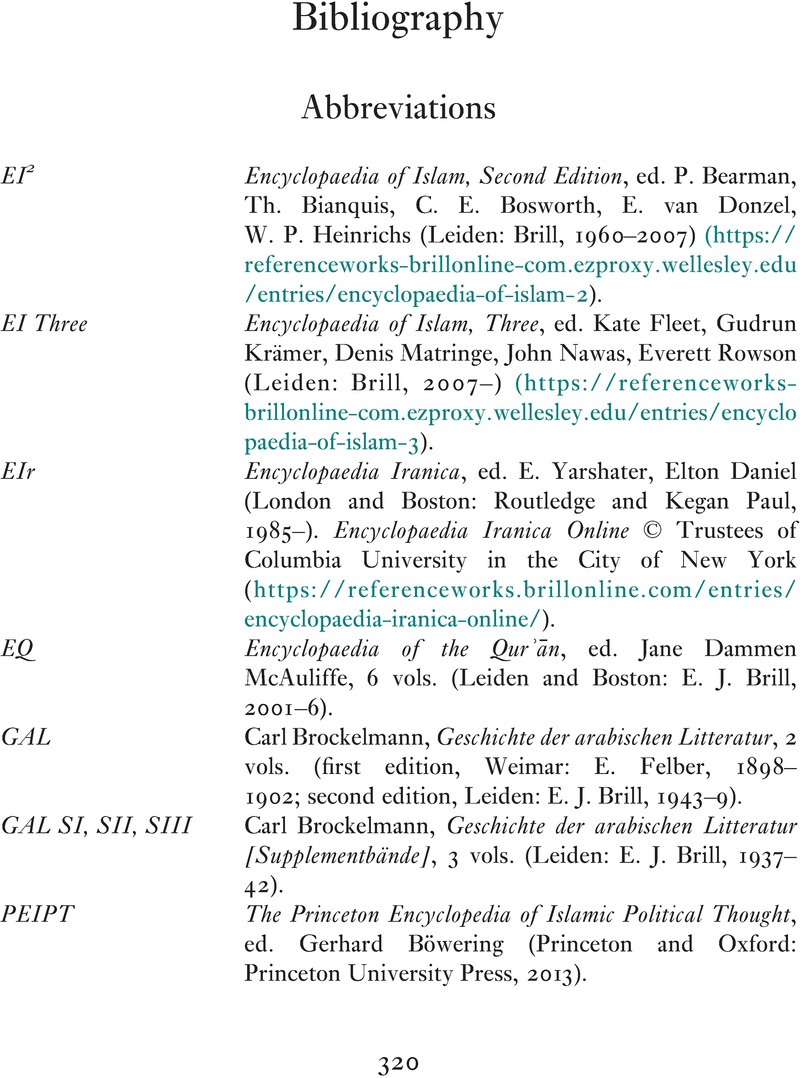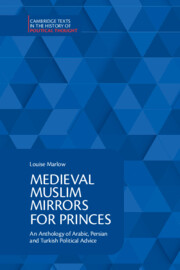Book contents
- Medieval Muslim Mirrors for Princes
- Cambridge Texts in the History of Political Thought
- Medieval Muslim Mirrors for Princes
- Copyright page
- Dedication
- Contents
- Figures and Maps
- Preface and Acknowledgements
- Conventions
- Abbreviations
- Part I Introduction
- Part II Texts
- Appendix Index of Qurʾanic References and Quotations
- Glossary
- Bibliography
- Index
- Cambridge Texts in the History of Political Thought
- References
Bibliography
Published online by Cambridge University Press: 15 January 2023
- Medieval Muslim Mirrors for Princes
- Cambridge Texts in the History of Political Thought
- Medieval Muslim Mirrors for Princes
- Copyright page
- Dedication
- Contents
- Figures and Maps
- Preface and Acknowledgements
- Conventions
- Abbreviations
- Part I Introduction
- Part II Texts
- Appendix Index of Qurʾanic References and Quotations
- Glossary
- Bibliography
- Index
- Cambridge Texts in the History of Political Thought
- References
Summary

- Type
- Chapter
- Information
- Medieval Muslim Mirrors for PrincesAn Anthology of Arabic, Persian and Turkish Political Advice, pp. 320 - 356Publisher: Cambridge University PressPrint publication year: 2023
References
Bibliography
Encyclopaedia of Islam, Second Edition, ed. P. Bearman, Th. Bianquis, C. E. Bosworth, E. van Donzel, W. P. Heinrichs (Leiden: Brill, 1960–2007) (https://referenceworks-brillonline-com.ezproxy.wellesley.edu/entries/encyclopaedia-of-islam-2).
Encyclopaedia of Islam, Three, ed. Kate Fleet, Gudrun Krämer, Denis Matringe, John Nawas, Everett Rowson (Leiden: Brill, 2007–) (https://referenceworks-brillonline-com.ezproxy.wellesley.edu/entries/encyclopaedia-of-islam-3).
Encyclopaedia Iranica, ed. E. Yarshater, Elton Daniel (London and Boston: Routledge and Kegan Paul, 1985–). Encyclopaedia Iranica Online © Trustees of Columbia University in the City of New York (https://referenceworks.brillonline.com/entries/encyclopaedia-iranica-online/).
Encyclopaedia of the Qurʾān, ed. Jane Dammen McAuliffe, 6 vols. (Leiden and Boston: E. J. Brill, 2001–6).
Carl Brockelmann, Geschichte der arabischen Litteratur, 2 vols. (first edition, Weimar: E. Felber, 1898–1902; second edition, Leiden: E. J. Brill, 1943–9).
Carl Brockelmann, Geschichte der arabischen Litteratur [Supplementbände], 3 vols. (Leiden: E. J. Brill, 1937–42).
The Princeton Encyclopedia of Islamic Political Thought, ed. Gerhard Böwering (Princeton and Oxford: Princeton University Press, 2013).

